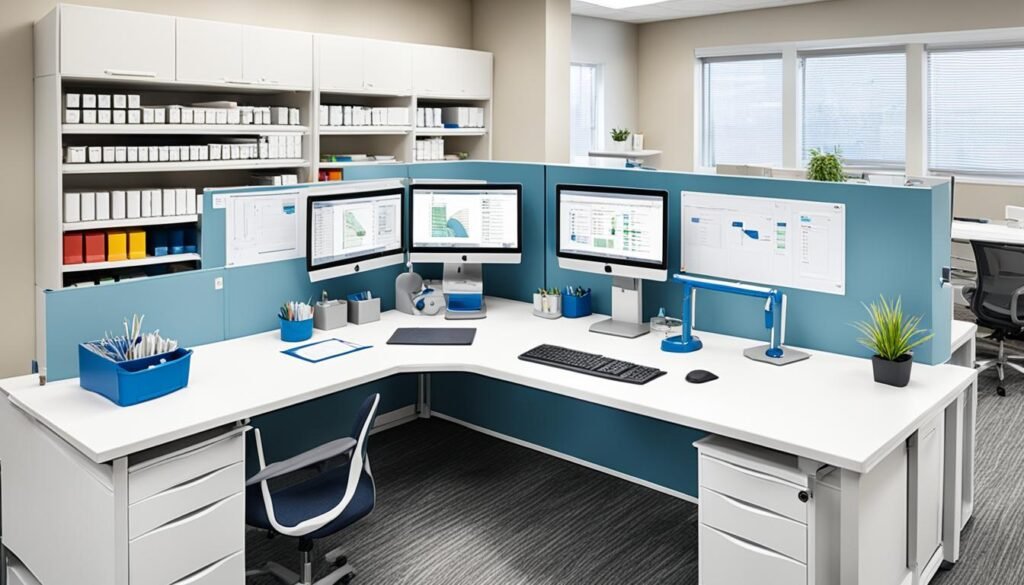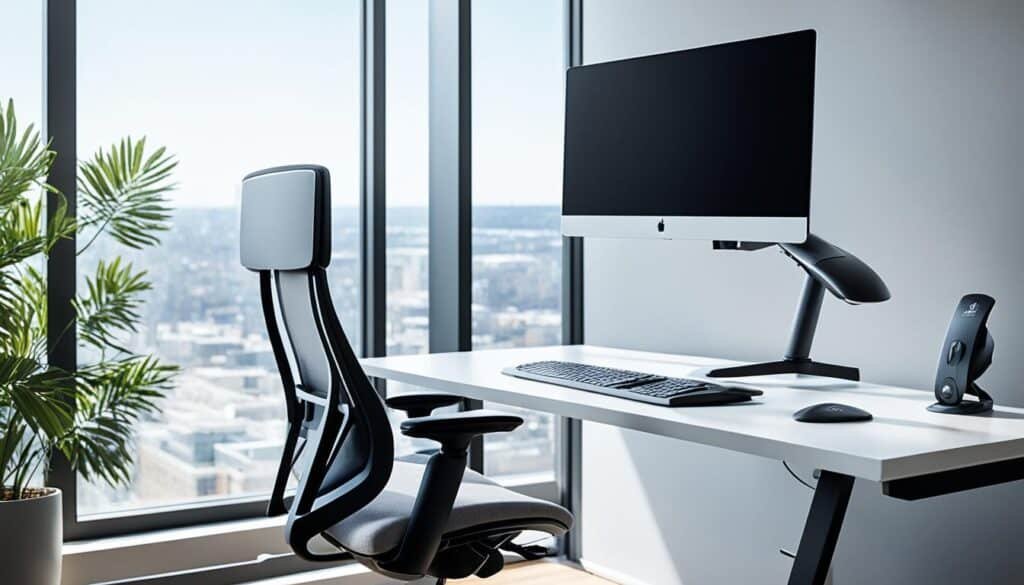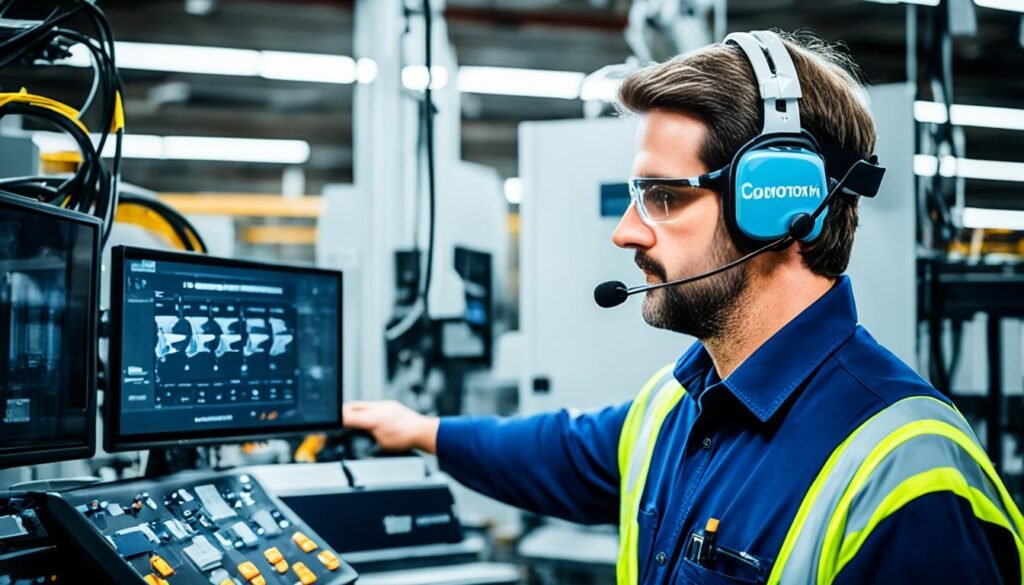In today’s fast-paced world, cognitive ergonomics is key to improving work life and efficiency in many fields1. It focuses on mental processes like how we see, remember, reason, and move, which affect how we interact with our work and the world2. By making work environments better for our minds, companies can help their teams work at their best. This leads to more innovation, productivity, and success.
Investing in cognitive ergonomics brings big benefits for both workers and companies. Things like clean air, the right temperature, good lighting, and quiet spaces can boost brain power by up to 50 percent1. This makes workers happier and more satisfied, and it helps businesses too by increasing productivity, cutting down on sick days, and improving how decisions are made.
Ergonomics is changing, with neuroergonomics being a big part of that change2. Neuroergonomists work on making technologies that help our brains work better at work and at home2. By using science and design, companies can make places that help our minds stay clear, reduce stress, and keep workers fully engaged and productive.
🎯 Ready to Transform Your Results?
Get the complete system that hundreds have used to achieve breakthrough results.
Get the Book for $7Key Takeaways
- Cognitive ergonomics aims to make work better for our minds.
- Investing in it can boost brain power by up to 50%, leading to better work and decisions.
- Neuroergonomics uses science to make technologies that help our brains and how we interact with them.
- Improving things like air quality, lighting, noise, and temperature can really help our brains and well-being at work.
- Companies that use cognitive ergonomics can get ahead and add value to their spaces.
Understanding the Importance of Cognitive Ergonomics in the Workplace
In today’s fast-paced work world, cognitive ergonomics is key. It aims to make work better and safer, reduce mistakes, and lower stress3. By making work easier on the mind, companies can help their teams work better, faster, and with less stress.
Defining Cognitive Ergonomics
Cognitive ergonomics looks at how our minds work with our jobs and the tools we use. It covers things like how we see, pay attention, and remember3. By using science, it designs work spaces that fit how our brains work best.
There’s no single way to measure mental workload, but it’s about how much mental effort a task takes3. Cognitive ergonomics tries to make tasks just hard enough to keep us engaged but not so hard they overwhelm us.
The Impact of Cognitive Ergonomics on Employee Well-being and Productivity
Using cognitive ergonomics helps make work better for employees. It makes work less stressful and clearer, cutting down on stress-related health issues and missing work3. It also makes people work better, with fewer mistakes and better results.
Studying how we think helps design better tools and work spaces for specific jobs3. In places like power plants and hospitals, it’s key for keeping workers safe and performing well4. But it’s also important in everyday jobs like banking and office work4.
The goal is to make systems safe, efficient, and easy to use. By thinking about how people think and feel, designers can make things that fit how we expect them to work4.
By focusing on cognitive ergonomics, companies get a healthier, more engaged team. They show they care about their workers and get ahead with better thinking and new ideas.
Factors Affecting Cognitive Performance in Work Settings

Many things can change how well we think at work. This includes the physical setup of our workspace and the type of tasks we do. It’s key to look at these things to make sure we work well and stay healthy. Cognitive ergonomics helps make work better by improving how people and their work environments work together5.
Environmental Factors: Lighting, Noise, Temperature, and Air Quality
Our work environment affects how we think. Bad lighting can cause eye problems and make it hard to focus. Too much noise can distract us and make us tired. Extreme temperatures and bad air can mess with our minds too. By using cognitive ergonomics, companies can make work safer and reduce mistakes5.
Workstation Design and Ergonomics
How our workstations are set up is very important for our thinking. A bad setup can make us uncomfortable, unfocused, and stressed. Ergonomic checks can show what needs to be better, like desk heights or computer placement. A good workspace helps us stay focused and avoid getting tired, making us more productive.
Task Complexity and Mental Workload
How hard our tasks are and how much we have to think can affect our thinking at work. Hard tasks or ones that need a lot of focus can make us tired and less aware of our surroundings. Cognitive ergonomics helps spread out work and make tasks easier, cutting down on mental strain5. By looking at what tasks need from our minds and making changes, companies can keep workers sharp and safe.
From an initial pool of 61,781 papers, a final sample of 64 articles were kept for study. These 64 articles were sorted into work-related topics: shift work (n = 39), sitting too much (n = 7), work stress (n = 12), long work hours (n = 3), and expertise (n = 3). Shift work, work stress, and long hours were seen as bad for thinking at work6.
Understanding what affects our thinking at work helps companies make better work places. By using cognitive ergonomics in design, tasks, and policies, we can improve focus, reduce tiredness, and make work more efficient.
Assessing Cognitive Ergonomics in the Workplace
In today’s fast-paced work world, making sure employees are comfortable and productive is key. By doing ergonomic evaluations, companies can spot issues that cause strain. This helps keep workers safe and boosts productivity.
Checking cognitive ergonomics is crucial for making work safe and easy to use7. Studies show that focusing on cognitive ergonomics can make workers more productive. It also helps reduce health issues and makes work better for employees8.
Conducting Cognitive Ergonomic Assessments
Companies can use different methods to check cognitive ergonomics. Cognitive task analysis (CTA) finds problems in tasks that cause errors or stress7. Cognitive modeling (CM) helps predict how people will act, helping design better options7.
TuMeke is changing how we do ergonomic checks with new tech. They use smartphone cameras to analyze how workers move and stand. This makes ergonomic evaluations easier and more useful. With this tech, companies can see what challenges their workers face and fix them early.
Identifying Areas for Improvement
After checking cognitive ergonomics, finding ways to get better is the next step. This means looking at the data to see what’s causing problems. By checking things like job satisfaction and work engagement, companies can understand what’s affecting their workers8.
With this info, companies can create tailored ergonomic solutions. These might include using cognitive work design (CWD) to match tasks with workers’ skills and likes7. They can also use cognitive ergonomics guidelines (CEG) to make work environments better for everyone7.
By focusing on cognitive ergonomics and checking in often, companies can make a healthier, more productive workplace. A study on cognitive ergonomics shows that managing work stress can protect workers, teams, and even society8.
Optimizing Lighting for Enhanced Cognitive Performance

Lighting is key to a great work environment. It helps keep us alert, cuts down on eye strain, and lowers mistakes. Natural light is especially good for our minds and health9. By choosing the right lighting, we can make our minds work better and be more productive at work.
Studies show that how bright the light is affects our thinking. Brighter light makes us quicker and more accurate in tasks9. The European standard says offices need 500 lux of light. Other places suggest 300-500 lux is best10. These rules help make workspaces that keep our minds sharp and reduce mistakes.
The color of light is also important for our thinking. Blue light makes us feel better, more awake, and more productive9. Research says blue light changes our brain waves more than red light. This means the best light levels might depend on the type of light we use9.
“Lighting is not just about visibility; it’s about creating an environment that nurtures our cognitive abilities and fosters a sense of well-being.”
To find the best lighting for a workspace, we need to check it out closely. We can use special meters to measure the light quality. This helps us see what needs to change and how to make it better for our minds.
When making lighting plans, we must think about everyone’s needs and the tasks they do. The right light levels for thinking can be between 400 lux and 1000 lux, depending on the task10. Some studies show that 750 lux is better for speed and focus10. Others say 400 lux is best for memory10. By adjusting the light for each task, we can make a space that helps us think our best.
Using natural lighting at work is also smart. Daylight makes us happier, more alert, and healthier9. By placing windows right, using skylights, and reflecting light, we can use daylight to make work better and more exciting.
In conclusion, making the right lighting choices is key to making work better for our minds. By using the latest in lighting design, we can create spaces that keep us alert, reduce eye strain, and cut down on mistakes. With the right mix of brightness, color, and natural light, we can reach our full potential at work.
Managing Noise Levels to Minimize Distractions and Cognitive Strain
In today’s fast-paced work settings, managing noise is key to keeping minds sharp and workers happy. Studies reveal that noise affects both hearing and mental health, impacting focus and overall well-being11. Open-plan offices, for example, can make it hard for employees to concentrate, leading to work disruptions11. So, it’s vital to reduce noise and create quiet areas for better work and mental health.
Implementing Noise Reduction Strategies
To lessen noise’s harm on focus, we need to use various strategies. These should improve sound design, use noise-cancelling tech, and teach noise awareness. Some good ways to reduce noise include:
- Adding sound-absorbing materials like acoustic panels, carpets, and curtains to lessen echoes
- Using white noise machines or background music to mask distracting sounds and improve focus11
- Encouraging the use of noise-canceling headphones for better focus in loud places
- Setting rules for noise levels and teaching respect for quiet workspaces
These steps can greatly lessen noise’s effect on focus, helping workers stay sharp and precise in their tasks.
Creating Dedicated Quiet Zones
Along with noise reduction, quiet zones in the workplace help workers focus on tasks needing deep thought. These areas should focus on sound comfort, with things like:
| Element | Description | Benefits |
|---|---|---|
| Sound-insulated walls | Walls with high sound transmission class (STC) ratings to block outside noise | Reduces distractions and offers privacy |
| Comfortable seating | Chairs and seating that support good posture and relaxation | Lessens physical strain and improves focus |
| Natural lighting | Windows or skylights for natural light | Boosts mood, alertness, and brain function12 |
| Plants and green spaces | Adding indoor plants and green elements | Improves air quality and soothes the mind |
Quiet zones give workers a place for deep focus and mental clarity, leading to better work and productivity.
Nocturnal aircraft noise can hurt cognitive skills the next day, showing the need to think about noise’s effects beyond the office13. This underlines the importance of managing noise to protect workers’ mental and cognitive health.
In summary, managing noise with strategies and quiet zones is key to reducing distractions and strain at work. By focusing on sound design, noise-cancelling tech, and awareness, we can create an environment that supports sharp thinking, precision, and focus.
Ensuring Optimal Temperature and Humidity for Mental Clarity

As an expert in cognitive ergonomics, I’ve learned that temperature is key for top brain performance and keeping motor skills sharp. High and low temperatures can really affect how well we think and react. For example, a 1°C rise in temperature can cut performance by 2%14.
How we feel the temperature also matters for our brain power. Feeling cool or just right can make us make fewer mistakes and work faster, no matter who we are or how used to the temperature we are15. The best temperature for thinking clearly is when it feels slightly cool to neutral15.
Keeping the right temperature indoors is key since most of our work is done inside14. IAQ sensors help us see where it’s hot or cold, so we can sit where we think best. Men and women have different ideal temperatures for thinking clearly, with men at 68-69 degrees and women at 70-72 degrees.
| Temperature Range | Effect on Cognitive Performance |
|---|---|
| 18°C (Low) | Decreased accuracy, slower response time |
| 22°C (Moderate) | Optimal for cognitive performance |
| 30°C (High) | Decreased accuracy, slower response time |
| Slightly Cool to Neutral | Lower error rates, increased speed |
Employers need to understand how temperature affects their workers’ health and work. By keeping the right temperature and humidity, companies can help everyone think clearly, move well, and work together better.
Thermal comfort is not a luxury, but a necessity for peak cognitive performance in the workplace.
In the end, focusing on cognitive ergonomics and keeping the right temperature and humidity helps us work better. It supports clear thinking, boosts productivity, and improves overall health.
Improving Air Quality to Boost Cognitive Function
We spend about 90% of our time indoors, making good indoor air quality key for our health and work performance16. A green office with clean air can make people think better, up to twice as much as in places without good air16. Adding more plants and better air flow can make workers think better and feel better.
Monitoring and Maintaining Indoor Air Quality
Keeping the air clean is key for good thinking. Just a little more air flow can make workers 8% better, adding $6,500 a year to productivity16. Using a system to check the air for pollutants is a smart move.
The EPA says indoor air has many pollutants that can harm us16. These can hurt our health if there’s too much of them16. To fix this, the EPA suggests getting rid of pollution sources, improving air flow, and using cleaners.
| Strategy | Actions |
|---|---|
| Eliminate Sources | Avoid products that emit harmful VOCs, maintain proper ventilation, and control humidity levels between 30-50% |
| Improve Ventilation | Increase ventilation rates before rooms become crowded, tie HVAC systems to room booking systems, and encourage regular maintenance |
| Use Air Cleaners | Invest in quality room air cleaners, maintain office plants, and use HEPA filtration systems |
Incorporating Plants and Green Spaces
Adding plants and green areas at work makes the air cleaner and the place nicer16. Plants clean the air, taking out bad stuff and adding oxygen. This can make people feel less tired and less bothered by headaches and other issues16.
Good workspaces that support talking and working together make teams work better17. Adding plants and green areas makes the office a nicer place, helping workers feel and do better.
Improving air quality at work is about caring for your employees’ health and well-being.
Checking the air quality often and following advice from groups like the EPA is important16. Getting workers to speak up about air quality and keeping the office clean helps keep the air fresh16. Using air purifiers like the FreshView Wellness Monitor Stand is a smart way to clean the air at work16.
By focusing on clean air and adding plants, companies can make a better work place. This helps workers think and feel better, which is good for everyone involved.
Designing Ergonomic Workstations for Enhanced Focus and Productivity

Creating an ergonomic workstation is key for keeping your mind sharp and staying healthy at work. By focusing on ergonomic design, companies can cut down on physical strain and health problems. This leads to happier employees and a better work environment18.
Adjustable Furniture and Equipment
Adjustable furniture is a big part of an ergonomic workstation. Desks and chairs that change height are popular because they let workers set up their space just right. This helps avoid back and neck pain18.
Ergonomic chairs support your lower back and keep your knees at or below your hips. Feet should rest flat on the ground19. Having furniture you can adjust can make you more comfortable and lower the risk of musculoskeletal disorders20.
Monitors should be about 20 to 40 inches away to prevent eye strain and keep you standing right19. Monitor arms that move let you set your screen just right for you.
Ergonomic Peripherals and Accessories
Ergonomic accessories are key to reducing strain and boosting focus. Ergonomic keyboards stop wrist bending and make work more comfortable19. They keep your wrist in a neutral position, cutting down on carpal tunnel syndrome and other injuries.
Ergonomic mice also help by reducing joint pain from using the computer a lot. They match the shape of your hand for a more natural position.
Wearable posture sensors are a new tool to keep you standing up straight all day. They connect to your phone and tell you if you’re slouching. This helps avoid headaches and neck pain that can mess with your focus1920.
| Ergonomic Equipment | Benefits |
|---|---|
| Adjustable Desks | Reduce risk of back and neck pain, improve posture |
| Ergonomic Chairs | Provide lumbar support, promote proper alignment |
| Ergonomic Keyboards | Prevent wrist bending, reduce risk of carpal tunnel syndrome |
| Ergonomic Mice | Fit natural hand contours, reduce joint pain and discomfort |
| Wearable Posture Sensors | Alert users to slouching, encourage healthy posture |
By adding adjustable furniture, ergonomic gadgets, and new accessories, companies can make workstations that boost focus and well-being. These ergonomic solutions cut down on physical strain and make the workplace healthier and more satisfying1820.
Managing Task Complexity and Mental Workload
https://www.youtube.com/watch?v=h0t9Q_nvKoo
In today’s fast-paced work environments, managing task complexity and mental workload is key for employee well-being and performance. Cognitive overload can lead to less productivity, more errors, and more stress. To avoid these issues, organizations should focus on cognitive ergonomics and strategies to lessen mental strain.
Streamlining workflow design is a good approach. Simplifying processes and cutting out unnecessary steps can reduce the mental load on employees. This is crucial in industries like logistics and manufacturing where work never stops. Signs of cognitive overload include more product defects and mistakes in picking orders21.
Implementing simplified control interfaces is another strategy. In complex settings like chemical plants, better labels and controls can keep mental clarity high and reduce fatigue. Ratings scales measure different loads, including perceptual and central processing loads21.
The technique of magnitude estimation measures load differences well21.
Improving operational efficiency with ergonomically designed control rooms helps prevent cognitive fatigue. Clean layouts that make information easy to access keep employees focused and alert. Google Scholar has lots of research on “mental workload” and “cognitive workload”22.
- Do regular cognitive ergonomic checks to find areas to improve.
- Offer training and resources for managing mental workload well.
- Encourage talking and feedback to tackle cognitive strain early.
There are many ways to define mental workload, which makes it hard to agree on a single framework22. But, by focusing on cognitive ergonomics and specific interventions, companies can make work environments that support top mental performance and employee well-being. Surveys and reviews on mental workload often focus on certain areas, showing the need for a full approach to handling task complexity and cognitive demands at work22.
Incorporating Cognitive Ergonomics in Human-Computer Interaction

Technology is getting more advanced, making human-computer interaction (HCI) key in designing systems that work well with people. Cognitive ergonomics is vital in this effort. It makes sure interfaces support our brains for better performance and less mental effort23.
Recent studies show how important cognitive ergonomics is in designing big language models (LLMs) and their interfaces. But, current LLM designs often miss this important part. They don’t fully use cognitive science to fix biases in LLM answers23. Also, LLM interfaces often don’t follow user-centered design and don’t explain their choices clearly23.
Designing User-Friendly Interfaces
Creating interfaces that are easy to use is crucial for cognitive ergonomics in HCI. By using cognitive ergonomics, designers make interfaces simple, easy to navigate, and less tiring for users. They organize information clearly, reduce distractions, and use visual cues to help users23.
Cognitive ergonomics also says it’s important to change designs based on what users say and like23. By listening to users and testing usability, designers can make interfaces better match what users need. This leads to happier users and better work performance.
Optimizing Information Visualization
Good information visualization is key in cognitive ergonomics in HCI. By making data clear and engaging, designers help users understand complex ideas and make good choices. They use charts, graphs, and other visuals to share information well23.
“Cognitive ergonomics ensures information is structured clearly and intuitively, reducing cognitive load.”23
Improving information visualization also means thinking about color, typefaces, and layout to make interfaces look good and easy to read. By doing this, designers help users process information better and make smarter decisions23.
In geographic information systems (GIS), cognitive ergonomics is crucial for better human-computer interaction. Many methods for developing information systems are linked to HCI theories and models. A framework for adding cognitive ergonomics aspects is given24. The importance of human factors in GIS is stressed, showing how cognitive modeling is key in HCI24.
As cognitive ergonomics grows, it’s important for researchers and designers to work together. They should aim to create systems that improve how our brains work and expand our brain abilities through new training methods23. By adding cognitive ergonomics to LLM design and other HCI projects, we can support ethical and inclusive practices. This benefits users and society23.
Cognitive Ergonomics in the Age of Remote Work

Remote work is becoming more common, bringing both challenges and chances for cognitive ergonomics. It’s key to make remote work environments better for mental health and productivity. By using smart strategies, remote workers can keep their minds sharp and stay well while working from home.
Challenges and Opportunities of Remote Work Environments
Remote work has its ups and downs for cognitive ergonomics. Workers might face more technostress, with 56-62% dealing with it during the COVID-19 pandemic25. Also, 31-40% saw their mental health change early on in the pandemic25. Yet, it also lets people have more control over their work space. A survey found differences between those new to remote work and those who’ve been doing it longer26.
One big issue is less physical activity and sitting too much. Studies show 77-83% of those working from home changed how active they were and how much they sat25. This can cause discomfort, like neck pain and headaches, in 23-29% of workers after five days25. To fix this, focus on making workstations ergonomic and taking breaks to move around.
Best Practices for Maintaining Cognitive Well-being While Working from Home
To keep your mind sharp while working from home, follow some key tips. Use your body’s natural circadian rhythm to plan work breaks and peak productivity times. Set alarms to mark when you’re most and least energetic. This helps you take breaks at the best times, improving focus and reducing tiredness.
Adding mindfulness and meditation to your day can also help fight mental fatigue and boost brain power. Research shows 69-75% of people felt less tired after video calls during the pandemic25. Short mindfulness or meditation sessions throughout the day can help you focus better and avoid multitasking.
The same work setup can be stressful or a chance, based on the person27.
Other ways to stay mentally sharp while working from home include:
- Creating a dedicated workspace with good lighting and ergonomic furniture
- Setting clear lines between work and personal life
- Doing regular exercise and stretching
- Keeping in touch with colleagues online
| Cognitive Ergonomic Factor | Impact on Remote Workers | Best Practices |
|---|---|---|
| Technostress | 56-62% of workers faced increased technostress during the COVID-19 pandemic while teleworking25 | Provide technical support and training, encourage breaks from technology |
| Mental Well-being | 31-40% of teleworkers reported experiencing mental well-being changes during the early stages of the COVID-19 pandemic25 | Promote mindfulness and meditation, encourage open communication |
| Physical Activity and Sedentary Behavior | 77-83% of telecommuters observed alterations in their occupational physical activity and sedentary behavior due to working from home25 | Encourage regular movement breaks, provide ergonomic workstation setups |
By using these tips and understanding remote work’s challenges and chances, companies can make cognitive ergonomics a key part of their work culture27. This will help everyone’s health, ability to do their job, and safety, leading to better work performance26.
Training and Education on Cognitive Ergonomics

Cognitive ergonomics aims to make jobs better and reduce mistakes and tired minds at work28. To make this work, companies need to offer good training and awareness programs. These should teach employees how to make their work areas better for their minds and health.
Old-school training can be boring and not keep people’s attention well28. Using cognitive ergonomics in training can make safety training more fun and useful28. Things like interactive learning and pictures can really help people pay attention and remember what they learned28.
Doing things like acting out scenarios and getting hands-on can make training stick in people’s minds28. Pictures and videos can make hard safety ideas easier to understand and remember28. When people take part in training, they learn and remember more28. Using real-life examples in training makes it more relevant and helps people follow safety rules better28.
TuMeke, a company using cognitive ergonomic ideas, uses AI and pictures to make training easier and make work safer28.
Cognitive ergonomics started in the 70’s with the rise of personal computers and new ideas in psychology and AI29. It’s different from physical ergonomics, focusing on how psychology can make work better and improve how people work with their jobs29. It’s all about designing things with the user in mind, especially when making technology29.
Making things accessible is key in cognitive ergonomics, especially with laws in the U.S. that require websites and technology to be usable by everyone29. This means using sounds and pictures, making things work with a keyboard or voice, and making sure everyone can use it29. Good accessible content doesn’t just rely on color, has clear image descriptions, works with a keyboard or voice, has transcripts for podcasts, and lets people see audio in videos29.
To keep getting better at cognitive ergonomics, companies should check in often and see where they need more training. By keeping up with new research and tech, companies can keep their work places focused on making things better for everyone’s minds.
Cognitive Ergonomics: Industry-Specific Applications and Case Studies

Cognitive ergonomics is key in making work environments better across different industries. It helps workers perform at their best and stay well. By using cognitive ergonomics, companies can boost productivity, cut down on mistakes, and make things easier for users30.
Manufacturing and Industrial Settings
In places like manufacturing, cognitive ergonomics makes a big difference. It looks at how complex tasks affect the mind. Studies show that complex tasks can make the brain work harder, but in a good way31.
By applying cognitive ergonomics, companies can ease the mental load, lower mistakes, and improve quality. For example, a study found a way to accurately track hand movements with just one sensor31. This tech could make assembly lines run smoother and ease worker strain.
Healthcare and Medical Environments
In healthcare, cognitive ergonomics is crucial for keeping patients safe and making work flow better. Electronic health records (EHRs) are now a big part of healthcare, and good design makes them easier to use30.
It also helps cut down on medical mistakes and improve decision-making. By making interfaces clear and easy, doctors and nurses can focus on caring for patients better. A study showed some promising results, but more research is needed31.
Office and Knowledge Work
In offices and knowledge work, cognitive ergonomics is key for staying focused, creative, and productive. Open office layouts are popular, but they can be noisy and distracting. A study looked at how 1169 office workers felt about their work conditions32.
| Office Layout | Advantages | Challenges |
|---|---|---|
| Open Office | Collaboration, Communication | Noise, Distractions |
| Private Offices | Concentration, Privacy | Isolation, Reduced Collaboration |
| Hybrid Layout | Flexibility, Balance | Space Allocation, Cost |
Using cognitive ergonomics in office design helps make work better for everyone. Things like quiet areas, adjustable desks, and ergonomic tools can make a big difference. Surveys and usability tests can show how well these changes work3032.
As technology changes, cognitive ergonomics will keep being key to making work environments better for everyone.
The Future of Cognitive Ergonomics: Emerging Trends and Technologies

The field of cognitive ergonomics is set for big changes, thanks to new trends and tech. Artificial Intelligence (AI) will change how we improve mental performance at work33. Wearable devices will be key, collecting data on how our minds work and alerting us to dangers33.
The Internet of Things (IoT) will make cognitive ergonomics even better, letting us control and sense things remotely33. Already, wearable sensors are being used to check how people work, showing great promise34. For example, Toyota cut the time to do risk assessments by 95% and improved lifting by 84% with wearable sensors35.
Virtual Reality (VR) and Augmented Reality (AR) are being used by companies like Lockheed Martin and John Deere for design and training35. These techs create real-like simulations, helping workers learn and stay alert for tough tasks. Early stages of computer vision tech are also helping with ergonomic checks, making things like RULA and NIOSH Lifting Equation easier3534.
“The future of cognitive ergonomics lies in the seamless integration of emerging technologies, creating adaptive and personalized work environments that optimize human cognitive performance.”
Exoskeletons and exosuits are still new but show promise in cutting down muscle work and boosting productivity3534. But, we must watch out for the mental load they might add35. The American Society for Testing and Materials (ASTM) is working on standards for these devices34.
As cognitive ergonomics grows, it’s key for companies to look at new tech carefully. They should think about cost, how big it can get, data quality, security, privacy, and power35. By using these new tools wisely, many industries can make their work better and healthier34.
Conclusion: Embracing Cognitive Ergonomics for a Healthier, More Productive Workforce
Cognitive ergonomics helps make work environments better and supports top mental performance. It looks at physical, cognitive, and organizational factors that affect workers’ well-being and productivity. By focusing on these areas, companies can build workplaces that put people first.
Investing in ergonomic assessments, training, and technology is key. So is creating a culture that values ergonomic awareness and ongoing improvement. This approach has been proven to cut musculoskeletal disorders by 61% and staff turnover by 87%3637.
Using cognitive ergonomics in design leads to better productivity and health for employees. It also boosts engagement, safety culture, and reduces physical discomfort. This means less absenteeism, pain, and mental fog, and a safer workplace37.
Ergonomic upgrades like adjustable desks and chairs help reduce fatigue and lower the risk of diseases and injuries. This leads to lower insurance costs for companies37.
The field of cognitive ergonomics is always changing. It’s important for companies to keep up with new research and best practices. This keeps them competitive and attracts the best talent.
By making cognitive ergonomics a key part of workplace design and employee well-being, companies can reach new heights of productivity and innovation. A comfortable and healthy work environment means lower employee turnover. This saves businesses money on recruiting and training new staff36.
FAQ
What is cognitive ergonomics?
Cognitive ergonomics is about making work environments fit the people who work there. It makes work more comfortable and efficient. It looks at how things like noise, lighting, and air quality affect our work.
How can cognitive ergonomics improve employee well-being and productivity?
Cognitive ergonomics makes work environments better for our minds. It reduces stress, cuts down on distractions, and helps us focus, think creatively, and work together better.
What environmental factors affect cognitive performance in work settings?
Things like lighting, noise, temperature, and air quality affect how well we work. Bad lighting can cause eye strain and headaches. Noise can distract us. And poor temperature and air quality can make it hard to think clearly.
How can businesses assess cognitive ergonomics in the workplace?
Businesses can check cognitive ergonomics by doing ergonomic checks. They look for things that cause strain. This includes checking how people move, the design of workstations, and how complex tasks are.
They use tools like computer vision and smartphone cameras to help with this.
What role does lighting play in cognitive performance?
Good lighting is key for staying alert and making fewer mistakes at work. Studies show people do 10-25 percent better in well-lit offices than in dark ones.
How can noise levels be managed to minimize distractions and cognitive strain?
To reduce noise, use sound design and noise-cancelling tech. Create quiet and busy areas for different tasks. Tools can check how loud it is to find the best solution.
What is the optimal temperature range for cognitive performance?
The best temperature for thinking well is between 68-72 degrees Fahrenheit. Men do best at 68-69 degrees, and women at 70-72 degrees. Tools can check the temperature to find the perfect spot for work.
How does air quality impact cognitive function?
Bad air quality, with high CO2 and pollutants, can make us feel foggy, sleepy, and dizzy. It can cut cognitive performance by up to 50 percent. Better air quality, with more ventilation and plants, helps keep our minds sharp.
What are some key considerations for designing ergonomic workstations?
Ergonomic workstations need adjustable furniture, monitor arms, and ergonomic keyboards and mice. This setup improves blood flow to the brain, cuts down on strain, and boosts focus and productivity.
How can cognitive ergonomics be applied in different industries?
Cognitive ergonomics can be adapted for various industries. In manufacturing, it makes assembly lines smoother and cuts down on mistakes. In healthcare, it makes patients safer and workflows more efficient. In offices, it helps design spaces that boost creativity and productivity.
What emerging trends and technologies are shaping the future of cognitive ergonomics?
New tech like AI, VR, AR, and wearables is changing how we work. These tools offer personalized help, immersive training, and support for complex tasks.
How can organizations embrace cognitive ergonomics to create a healthier, more productive workforce?
Companies can use cognitive ergonomics by looking at all the factors that affect workers. This means doing ergonomic checks, training, and using new tech. It also means creating a culture that values ergonomic awareness and keeps improving. By focusing on people, companies can do better and stay ahead.
